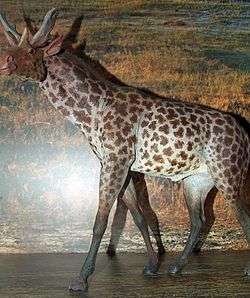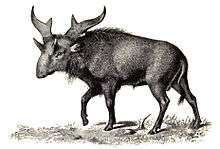Sivatherium
| Sivatherium | |
|---|---|
| Skull of S. giganteum | |
| Scientific classification | |
| Kingdom: | Animalia |
| Phylum: | Chordata |
| Class: | Mammalia |
| Order: | Artiodactyla |
| Family: | Giraffidae |
| Subfamily: | †Sivatheriinae |
| Genus: | †Sivatherium Falconer & Cautley, 1836[1][2] |
| Species | |
| |
| Synonyms | |
| |
Sivatherium ("Shiva's beast") is an extinct genus of giraffid that ranged throughout Africa to the Indian Subcontinent. The species Sivatherium giganteum is, by weight, the largest giraffid known, and also possibly the largest ruminant of all time.[3] The Afro-Asiatic species, S. maurusium, was once placed within the genus "Libytherium".
S. giganteum remains have been recovered from the Himalayan foothills, dating around 1,000,000 BCE. S. maurusium may have gone extinct as recently as 8,000 years ago, as depictions that greatly resemble it are known from ancient rock paintings in the Sahara[4] and Central West India.[5]
Description


Sivatherium resembled the modern okapi, but was far larger, and more heavily built, being about 2.2 m (7.2 ft) tall at the shoulder, 3 m (9.8 ft) in total height with a weight up to 400–500 kg (880–1,100 lb).[6] A newer estimate has come up with an estimated body mass of about 1,250 kg (2,760 lb).[3] This would make Sivatherium the largest ruminant in history. This weight estimate is thought to be an underestimate, as it does not take into account the large horns possessed by males of the species. Sivatherium had a wide, antler-like pair of ossicones on its head, and a second pair of ossicones above its eyes. Its shoulders were very powerful to support the neck muscles required to lift the heavy skull.[4]
See also
References
- ↑ Sivatherium in the Paleobiology Database
- ↑ Falconer, Hugh; Cautley, P. T. (1836). "Sivatherium giganteum, a new fossil ruminant genus, from the valley of the Markanda, in the Sivalik branch of the Sub-Himalayan Mountains". Journal of the Asiatic Society of Bengal: 38–50.
- 1 2 Basu, Christopher; Falkingham, Peter L.; Hutchinson, John R. (January 2016). "The extinct, giant giraffid Sivatherium giganteum: skeletal reconstruction and body mass estimation". Biology Letters. 12 (1). doi:10.1098/rsbl.2015.0940.
- 1 2 Palmer, D., ed. (1999). The Marshall Illustrated Encyclopedia of Dinosaurs and Prehistoric Animals. London: Marshall Editions. p. 278. ISBN 1-84028-152-9.
- ↑ "Rock paintings show species that roamed India". www.newindianexpress.com. Retrieved 2016-09-14.
- ↑ http://www.geocities.ws/rsn_biodata/Data/Sivatherium_giganteum.html (in Portuguese)
Further reading
- Barry Cox, Colin Harrison, R.J.G. Savage, and Brian Gardiner. (1999): The Simon & Schuster Encyclopedia of Dinosaurs and Prehistoric Creatures: A Visual Who's Who of Prehistoric Life. Simon & Schuster.
- David Norman. (2001): The Big Book Of Dinosaurs. pg. 228, Walcome books.
- After the Dinosaurs: The Age of Mammals (Life of the Past) by Donald R. Prothero
- The Evolution of Artiodactyls by Donald R. Prothero and Scott E. Foss
- Vertebrate Palaeontology by Michael J. Benton and John Sibbick
- Evolving Eden: An Illustrated Guide to the Evolution of the African Large Mammal Fauna by Alan Turner and Mauricio Anton
- Classification of Mammals by Malcolm C. McKenna and Susan K. Bell \
- The Book of Life: An Illustrated History of the Evolution of Life on Earth, Second Edition by Stephen Jay Gould
- World Encyclopedia of Dinosaurs & Prehistoric Creatures: The Ultimate Visual Reference To 1000 Dinosaurs And Prehistoric Creatures Of Land, Air And Sea ... And Cretaceous Eras (World Encyclopedia) by Dougal Dixon
- Eyewitness: Prehistoric Life by William Lindsay
- Walker's Mammals of the World (2-Volume Set) (Walker's Mammals of the World) by Ronald M. Nowak
- Horns, Tusks, and Flippers: The Evolution of Hoofed Mammals by Donald R. Prothero and Robert M. Schoch
External links
| Wikimedia Commons has media related to Sivatherium. |
| Wikispecies has information related to Sivatherium |